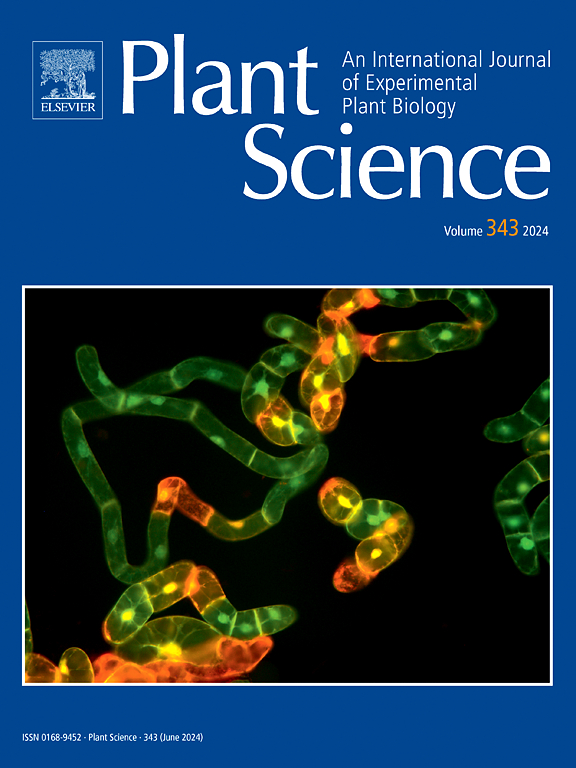AhGSNOR1 通过调节细胞内 NO 和氧化还原水平,对 Al 诱导的细胞程序性死亡进行负向调节。
IF 4.2
2区 生物学
Q2 BIOCHEMISTRY & MOLECULAR BIOLOGY
引用次数: 0
摘要
酸性土壤中的铝(Al)毒性会抑制植物生长并降低作物产量。程序性细胞死亡(PCD)是植物应对铝毒性的重要机制之一。然而,S-亚硝基谷胱甘肽还原酶(GSNOR)是否能提供铝-程序性细胞死亡尚不清楚。在这里,AhGSNOR1的转录和蛋白表达都受到了Al胁迫的诱导。AhGSNOR1-overexpressing 转基因烟草植株减少了铝诱导的一氧化氮(NO)和 S-亚硝基硫醇的积累,降低了铝胁迫对根系伸长的抑制作用和细胞死亡程度,并增强了抗氧化酶的活性,从而有效清除过氧化氢。此外,AhGSNOR1在体内直接与AhTRXh相互作用。在 AhGSNOR1 基因缺失的转基因植株中,Trxh3 的表达显著上调,表明 AhGSNOR1 能正向调节 Trxh3 的转录水平。这些结果表明,AhGSNOR1是铝诱导的PCD的负调控因子,并通过调节细胞内NO和氧化还原平衡提高植物对铝的耐受性。本文章由计算机程序翻译,如有差异,请以英文原文为准。
AhGSNOR1 negatively regulates Al-induced programmed cell death by regulating intracellular NO and redox levels
The toxicity of aluminum (Al) in acidic soil inhibits plant development and reduces crop yields. Programmed cell death (PCD) is one of the important mechanisms in the plant response to Al toxicity. However, it is yet unknown if S-nitrosoglutathione reductase (GSNOR) provides Al-PCD. Here, transcription and protein expression of AhGSNOR1 were both induced by Al stress. AhGSNOR1-overexpressing transgenic tobacco plants reduced Al-induced nitric oxide (NO) and S-nitrosothiol accumulation, the inhibitory effect of Al stress on root elongation and the degree of cell death, and enhanced antioxidant enzyme activity to effectively remove hydrogen peroxide. In addition, AhGSNOR1 directly interacted with AhTRXh in vivo. Expression of Trxh3 in AhGSNOR1-overexpressing transgenic plants was significantly upregulated, indicating that AhGSNOR1 positively regulated the transcriptional level of Trxh3. Together, these results suggested that AhGSNOR1 was a negative regulatory factor of Al-induced PCD and improved plant Al-tolerance by modulating intracellular NO and redox homeostasis.
求助全文
通过发布文献求助,成功后即可免费获取论文全文。
去求助
来源期刊

Plant Science
生物-生化与分子生物学
CiteScore
9.10
自引率
1.90%
发文量
322
审稿时长
33 days
期刊介绍:
Plant Science will publish in the minimum of time, research manuscripts as well as commissioned reviews and commentaries recommended by its referees in all areas of experimental plant biology with emphasis in the broad areas of genomics, proteomics, biochemistry (including enzymology), physiology, cell biology, development, genetics, functional plant breeding, systems biology and the interaction of plants with the environment.
Manuscripts for full consideration should be written concisely and essentially as a final report. The main criterion for publication is that the manuscript must contain original and significant insights that lead to a better understanding of fundamental plant biology. Papers centering on plant cell culture should be of interest to a wide audience and methods employed result in a substantial improvement over existing established techniques and approaches. Methods papers are welcome only when the technique(s) described is novel or provides a major advancement of established protocols.
 求助内容:
求助内容: 应助结果提醒方式:
应助结果提醒方式:


